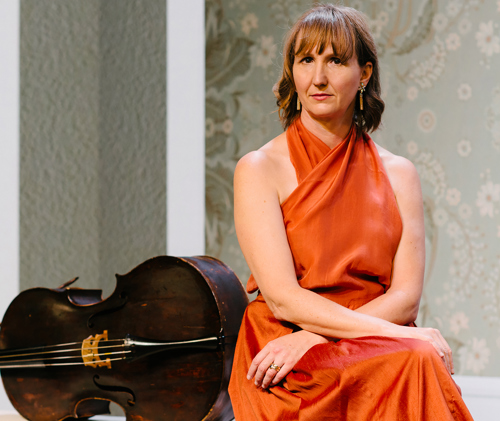Bach Series
Anthea Cottee Baroque Cello
BACH Nº 4
Anthea Cottee performs the Allemande from JS Bach's Suite No. 1 in G major for solo cello, BWV 1007

PROGRAM NOTES
Johann Sebastian Bach (1685-1750)
CELLO SUITE NO. 1 IN G MAJOR, BWV 1007
Allemande
While its exact date of composition remains unknown, many scholars agree JS Bach’s collection of Six Suites for Solo Cello was written while he was working as Kapellmeister for Prince Leopold of Anhalt-Cöthen between 1717 and 1723. At Cöthen musical life was focused on secular music: on playing music for fun and joy, for performances at court, and for social entertainment. Importantly, the prince (Bach’s junior by ten years) was an avid music lover and played several instruments fluently enough to perform alongside the professional musicians of his own orchestra.
The orchestra consisted of eighteen very highly skilled musicians, which allowed Bach to compose instrumental works of great variety and richness. The archives at Cöthen give us the names, origin and instruments of the musicians who inspired Bach to write virtuosic works for violin, violoncello, viola da gamba and flute. Carl Bernhard Lienecke, the orchestra's cellist during Bach’s tenure, may have been the first to play the solo cello suites. Unfortunately, that bit of information is also unknown to us. Furthermore, there is no surviving autograph copy of the suites as Anthea Cottee explains in her notes written during her preparation for this performance:
![]()
When I finally came to play the cello, the Bach Suites were some of the first pieces I learned. With such an iconic composition it is hard to know where to start. There is a sense each time you play them of uncovering layers of memory, the voices of teachers and the many recordings and performances you have heard, and of observing once again the beauty, humanity and depth of their construction. This sense of constant searching is compounded by the fact that the original manuscript of Johann Sebastian, thought to be composed about 1720, has never been found, and we find our way to the notes through various manuscripts penned by other hands. These manuscripts have histories, differences and discrepancies that have kept players and scholars of these works fascinated for many years and continue to do so.
Differences in articulation and notes imbue phrases with different meanings, and each copyist had their different habits and quirks. Bach’s second wife, Anna Magdalena, made a copy between 1727 and 1731. She was known to be a fairly accurate copyist with the notes, but careless or inconsistent with slurs and articulations. Johann Peter Kellner, a cantor and organist, made a copy around 1726 which appears to be from a different original source, as there are significant structural differences. Like Anna Magdalena, Kellner was imprecise with his articulation, and appears to have been less careful with his copying, with many wrong notes, duplicated or missing bars, and other additions that may, or may not, be by JS Bach.
In deciding what to play for this recording, I was drawn towards an appealing key to spend time with while in isolation: G major, described by Rameau in 1722 as the key that is right for both tender and happy songs. Each of the six suites has a prelude followed by a selection of dance-influenced movements, with their own specific character. From the first suite I chose three: Allemande, Courante and Sarabande, using the Anna Magdalena copy as my guide. In 1739, Johann Mattheson described the character of the Allemande as “a broken, serious, and well-constructed harmony, which is the good image of a content or satisfied spirit, which enjoys good order and calm”. The Courante, though spelled in the French manner is the faster Italian style, a lively running dance, and the Sarabande “has no other emotion to express but ambition… and maintains its seriousness”. In this time of great seriousness, Bach is a fine source of good order, tenderness and humanity.
ANTHEA COTTEE
WHAT TO LISTEN FOR
JS Bach would have encountered the eighteenth-century French version of the Allemande as a 15-year old student in Lüneburg; a figure dance in 4/4 or 2/4 time for four couples. In the first-ever dictionary of music and musicians written in the German language, Musicalisches Lexicon, Johann Gottfried Walther tells us the Allemande “must be composed and likewise danced in a grave and ceremonial manner.
Walther, who was in fact JS Bach’s cousin and, like Bach, an organist and composer, goes further and mentions a characteristic upbeat of one or occasionally three sixteenth notes. This description is consistent with the music Bach has composed: short semiquaver upbeats are followed by orderly, processional like arpeggiations exploiting the full range of the instrument.
Program Notes: Joanna Butler & Hugh Ronzani, 2020
Image Credit: Katelyn-Jane Dunn, 2020
BACH SERIES PRESENTING PARTNER
Artists
Listen
{% error.message %}
More for you...
{% series.name %}
Featured Content
{% series.featuredTitle %}















